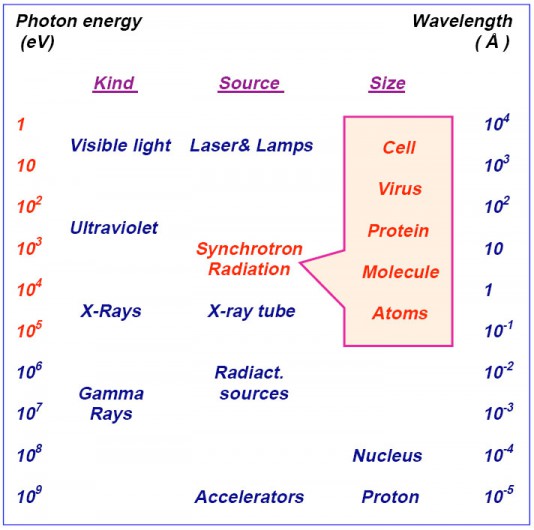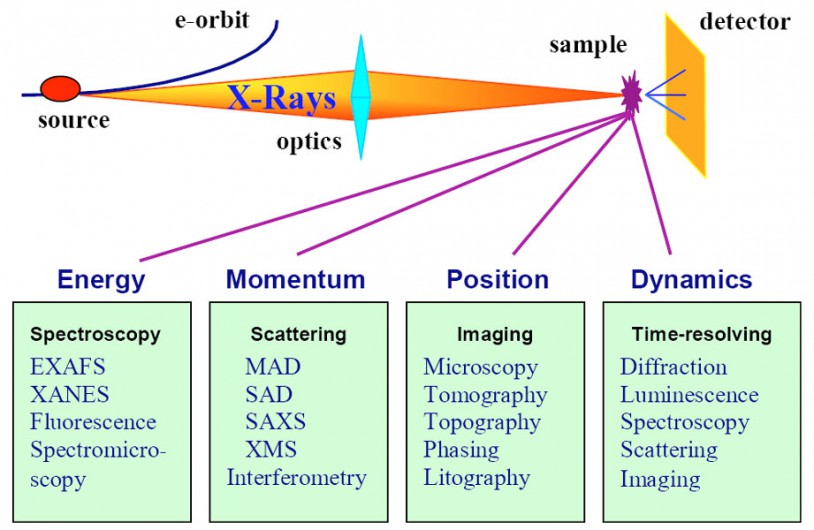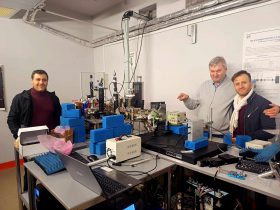Introduction
The unique properties of the synchrotron radiation are its continuous spectrum, high spectral flux and brightness, tunability and the relatively high coherency which makes this type of radiation a powerful tool for experimentalists to describe the nature of the micro-world and to develop new approaches in industrial applications at the molecular and sub-molecular level. For high energy electrons (few GeV), circulating in the storage ring, synchrotron radiation is extremely intense over a broad range of wavelengths: from the infrared (IR), visible, ultraviolet (UV) and the vacuum ultraviolet (VUV) range to soft and hard X-ray parts of the electromagnetic spectrum (Fig. 2.1). The continuous spectrum of synchrotron radiation provides more than five orders of magnitude increase in intensity (flux) and more than ten orders of magnitude increase in brilliance (brightness) than more co nventional sources as VUV lamps and X-ray tubes.

Fig. 2.1 Source and radiation characteristics.
The wavelengths of the emitted photons cover the dimensions from atomic level to cell structure and make it very effective tool for research in biology, medicine, material and environmental science, chemistry and metrology. The complexity of the fields under consideration (DNA and ligands, protein crystallography, chemical dynamics, crystal structure and growth etc) requires a complete description of the sample properties and state that includes four primary characteristics of the constituents namely: the energy, momentum, position and dynamics. The corresponding techniques and their combinations that realize these challenges using synchrotron radiation are: spectroscopy, scattering, imaging and time-resolved experiments.

Fig. 2.2 The primary sample characteristics and experimental technique.
CANDLE will provide synchrotron radiation for a large number of experimental groups (50-80) for different applications in parallel, each connected with the specific beamline. Highlights of research opportunities using synchrotron radiation from the CANDLE storage ring cover a broadband spectrum of the fundamental and applied researches that will be an actual at least in nearest 50 years.
Medical imaging and radiation therapy
Application of synchrotron X-ray beams for medical purpose has become an important part of the synchrotron radiation use and opens an opportunity for better medical diagnosis and treatment. Actually all modern synchrotron radiation sources now are accompanied by a satellite medical center. The highlights for medical therapy and diagnosis by use of synchrotron radiation of CANDLE synchrotron light source include:
- Angiography
- Bronchography
- Mammography
- Computed Tomography
- Microbeam Radiation Therapy
- Photon Activation Therapy
To cover this wide area of medical applications for radiation therapy and treatment, two beam lines, one from wiggler and one from bend magnet, can be delivered to the medical center as an extension of the end stations in the experimental halls of the CANDLE light source. The high brilliance and tunability of CANDLE x-ray beams can dramatically improve the speed, clarity and safety of diagnostic tools, such as coronary angiography and bronchography.
The coronary angiography is an X-ray procedure in which coronary vessels are made visible through the injection of iodine as a contrast medium. Two X-ray beams, one tuned to an energy readily absorbed by the iodine and one at the slightly lower energy, are used to record two images simultaneously. When the computer subtracts one image from the other, the contrast of view of the arteries is enhanced 150 000 times over that of bone or flesh. This extreme sensitivity allows the use of much lower iodine concentrations and lower X-ray doses, compared to conventional angiography. With such low iodine level, the contrast agent can be safely introduced through an arm vein. By using the high brilliance of CANDLE X-ray beams, an image can be formed in milliseconds, fast enough to make “movies” of the living, beating heart and nearby arteries. Monochromatic X-rays of sufficient intensity to visualize coronary arteries of 1 mm in diameter with an extremely low iodine mass density of 1 mg/cm2 are only provided by synchrotron radiation.
Bronchography is the similar technique applied for the imaging of lungs and respiratory passages. The patient inhales a gas mixture of xenon (80%) and oxygen (20%). The inspired volume is limited to the anatomic dead space, which includes the small bronchi but not the alveoli, and therefore virtually no xenon is absorbed. Moreover, this protocol limits overlap problems caused by xenon in the alveoli or in vascular structures. The patient then holds his/her breath for several seconds whilst dual energy imaging is performed in a manner very similar to that used for line scan coronary angiography. The only difference is that the energies are chosen to bracket the xenon K edge at 34.56keV. The technique could be particularly valuable in the early diagnosis of lung cancer, which is the leading source of cancer. It is calculated that K edge subtraction imaging using inhaled Xenon as a contrast agent could detect tumors that are significantly smaller than the 1cm limit of conventional techniques.
Mammography. As was stated recently in “Physics Today”, an application one of the diffraction-enhanced imaging approaches – mammography currently has a very high rate of false positives and false negatives. In a population of undiagnosed women advised by their doctors to have regular diagnostic screening, only five women out of 1000 will actually have breast cancer. But for that same population, the rate of positive mammograms will be 10% – the ratio of false positives to true positives is nearly 20:1. And for about 10-20% of women who have palpable abnormalities, the mammograms won’t show anything. There is thus a driving need to improve breast cancer detection technology using X-ray synchrotron radiation which can an orders of magnitude improve the diagnostics.
Macromolecular Crystallography
A macromolecular crystallography beam line is dedicated to the determination of the 3-dimensional structure of large biological molecules using X-ray diffraction. The scientific and application research program on the macromolecular crystallography using synchrotron radiation include a broadband problems related to life sciences:
- High Capacity Crystallography
- Enzyme Mechanizm
- Supra-molecular structure
- Molecular Recognition
- Nucleic Acids
- Structural Genomics
- Protein Structure
- Drug design
While the structures of DNA, RNA, or large molecular assemblies such as ribosomes and viruses may be studied, the principal focus will be on proteins. After sequencing the human genome, the next scientific challenge is to elucidate the structure and function of the proteins encoded by the genes. X-ray crystallography will provide the principal means by which these protein structures will be determined. The knowledge to be gained will have profound implications for our overall understanding of life processes in general, and for the understanding and treatment of disease. A protein’s structure has a major effect upon its functionality and knowledge of its amino acid sequence is insufficient to predict its function. Molecules pack in crystals in a way that is not random, but governed by the same rules that apply when the molecule binds to its macromolecular receptor. The results of high-resolution structure analyses extracted from X-ray diffraction studies of crystals therefore provide information that is invaluable for modeling drug-receptor binding. Drug design on the basis of this information is in its infancy, but is accelerating as a deeper understanding of the required structural principles emerges. The beneficial implications from the knowledge of these structures and hence perhaps the understanding of disease processes on a molecular level are enormous. The logical progression of this work is that it will soon be possible to design drugs to either activate or inhibit the action of individual proteins. Because proteins are large and flexible, protein crystals tend to be small, imperfect, and weakly diffracting compared to crystals of small molecules. In many cases, synchrotron radiation is vital for successful results. The intensity of the synchrotron beam allows data to be collected from the weakly diffracting protein crystals. The well-collimated X-ray beams can be focused to a size comparable to that of the samples used, typically on the order of 10-100 um. Collimation can also be particularly important for crystals with large cell dimensions where separation of reflections on the detector can be difficult. Another significant advantage of synchrotron radiation is that it provides the opportunity to select the energy of the X-ray beam. Tunability can allow experimenters to perform experiments that utilize the small variations in the intensity of diffracted reflections at different energies due to the resonant scattering of a heavy atom. Two popular techniques: SAD (single-wavelength anomalous dispersion) phasing and MAD (multi-wavelength anomalous dispersion) phasing rely on this effect. Because these techniques use only a single crystal and can provide phases very rapidly, when an anomalously scattering atom is naturally present or may be added to the crystal, MAD phasing and, increasingly, SAD phasing, are the favored techniques of most crystallographers today. As a consequence, beam lines optimized for these experiments are among the most oversubscribed
Material Science
The use of synchrotron radiation as the precise original tool for experimental research opens a wide range of applications in materials science using well developed technique like X-ray spectroscopy, X-ray diffraction, X-ray Analysis Study, ultraviolet spectroscopy etc. An area is covering a wide spectrum of the materials research from the semiconductors, polymers and ceramics to superconductors and layered structures.
- High temperature superconductivity
- Magnetism and magnetic materials
- Complex materials
- Heavy fermion behavior
- 2D Charge -Density-Wave materials
- Nano-structure and semiconductors
- Polymers, Biomaterials and Soft matter
Knowledge of the atomic structure and its modification under specific conditions are the basis for the development of the new materials that can be applied in computing, communications, manufacturing and nuclear waste treatment. One of the promising applications using synchrotron radiation is nuclear waste treatment using natural zeolites. There are more than 10 types of natural zeolites in Armenia and the deposit stocks are estimated at about 500 million tons. Zeolites are aluminosilicate materials with cage structure and micro-porous of molecular dimensions having sieve character. At present the most practical usage of natural zeolites, which are known as clinoptilolite, are widely distributed in Armenia. They have valuable physical-chemical characteristics and gain wide practical application as dryers of gas and liquid mediums, as absorbers of acid gases and radioactive ions, as well as deodorants. The high water absorption capability of zeolites and the ion exchange property allow their wide usage in liquid waste treatment, in oil industry, absorption of radionuclides from water in nuclear power plants.
Environmental and Earth science
Many spheres of human activity are result in strong, and as a rule, negative impact on the environment. Among them it is necessary to mention chemical industry, which is a source of highly toxic xenobiotics; civil and weapon nuclear technologies – source of radionuclides; metallurgy – source of heavy metals; transport – products of fuel combustion; agriculture – pesticides, fertilizers and so on. All these compounds enter the human organism through water, air or food. Many of them are dangerous already at very low concentration. Besides this, a lot of such contaminants can be accumulated in the organism, increasing their harmful effect. The topics of environmental sciences are numerous. Among them most important are:
- Determination of heavy metals, radionuclides, toxic organic compounds;
- Investigation of migration ways and accumulation places of these contaminants;
- Investigation of their utilization, identification and dead-end products;
- Investigation of influence of contaminants on ecosystem;
- Development of tools for environment monitoring;
These problems are closely interconnected and have a strong connection with biological sciences – biochemistry, biotechnology, microbiology etc. The solution of these problems require an investigations of physical, chemical, biological processes at the level of molecular scale in addition to macroscopic level. The study should be performed both at native conditions and under effect of contaminants. Only such a comprehensive approach allows the complete understanding and description of the fundamental mechanisms, which underlie the processes in the environment. In some regions of Armenia, a large amount of the waste products of cooper mining operations are concentrated. Determination of such elements as Cu, Cr, As, Te, Sb, investigation of their oxidation-reduction reactions and the migration ways will certainly help to receive the information on the geo-chemical processes in these regions, possible influence of harmful compounds on the environment and may become a basis for development of environmental protection actions. Such complex researches can be performed in Institute of Geology, Center of Ecological Researches, and in a number of related laboratories. Serious attention needs to be given to the problem of the ecology of Sevan Lake. Research of hydro-biological processes which take place in the lake, are carried out at chemistry department of the Yerevan State University. The study includes the circulation of nitrogen and phosphorus, migration and degradation of some xenobiotics, oxidation-reduction processes in water and active silt. The possibility to use synchrotron radiation for this purpose will allow the development of fundamental approaches to lake protection. What contaminants are rejected in the environment, how these contaminants interact with soil, plants, way of their migration with ground waters, changes related to this effects are not exhaustive list of the problems related to environmental science.
Micromechanics and Nanotechnology
The development of the experimental technique for X-ray imaging, known as LIGA (German acronym for Lithographe, Galvanoformung, und Abformung), made very effective the application of synchrotron radiation for the large integrated circuit fabrication and three dimensional device machining with very high resolution. The resolution comes from the extremely short wavelength of synchrotron radiation, of the order of 0.01-1.0 nm, and the high penetration ability, arising from the transparency of most materials in this region of the spectrum.
The LIGA technique is based on exposing a photoresist material by synchrotron radiation X-rays through properly designed mask and consists of deep-etched X-ray lithography, electroplating and micro molding. The main elements of the LIGA are the mask that carries the pattern to be transferred, imaging system and the storage medium (photoresist) deposited over the surface of the wafer. The incident X-ray synchrotron radiation produces the shadow of the mask pattern at the photoresist surface. A photoresist, a thin film of photosensitive material, is deposited on top of the wafer prior to exposure by the X-ray source. When the resist is exposed to the radiation, the mask pattern is stamped on the resist thus transferring the mask pattern to the wafer/resist layers. The method is having the growing applications in the fields of:
- Membranes, Signaling and Transport
- Macromolecular assemblies and machines
- Microelectronic Device Technology
- Micromachining and Microfabrication
- Optoelectronics and Semiconductor Manufacturing
- Crystallographic Nanotechnology.
Consequent using of different masks with various exposing time a complex structures can be produced with few mm height and sub-micron level of lateral resolution. LIGA technique can be used for production of microscopic machines known as MicroElerctroMechanical Systems, positioning structures and switching components for optical fiber communication, miniature motors, gears, pumps and heat exchangers, micro-optical components and microsurgical tools.
Chemistry and catalysis
An application of the synchrotron radiation in chemistry is one of the pronounced fields of the scientific highlights that can be conducted in CANDLE. The study of the excited state structures and the hollow atoms, the direct knowledge on the potential energy surface of the interacting species, the chemical dynamics, the investigation of the radioactive materials etc are not exhaustive list of the scientific program using synchrotron radiation. Many of these problems, especially connected with the complex chemical systems like the crystalline organic materials or catalysis mechanism need to be well understood and experimentally studied. The non-exhaustive list of application fields in chemistry is:
- Chemical Dynamics
- Heterogeneous
- Nanoscale chemistry
- Biochemistry
- Dynamics of Radicals
- Catalytic Interfaces
- Organic Crystal Chemistry
An important issue of the application research is the study of the catalysis mechanism. Catalysis mechanism that widely used in different chemical engineering processes, are not completely investigated on the atomic level. Because of economic and environmental reasons, detailed analysis in this field is one of the key directions in chemistry nowadays. Rapid development of the market of mobile phones, portable computers and other similar techniques strongly demand the existence of more light and chip rechargeable batteries with long-time operation life. Therefore, it is need to investigate new electrochemical reactions and understand chemical processes on an atomic level. The best way for such study is using absorption spectroscopy and X-ray diffraction technique. A strong interest nowadays in chemistry is connected with the polymers, a class of macromolecules with an extremely wide range of applications in industry. For the manufacturing and processing of polymers like polyurethane it is essential to know the chronology of the polymer formation. The very intense X-ray beam of CANDLE can permit the time-resolved SAXS study during the polymer formation. Making the user case for CANDLE will be in a priority list of the laboratory activity. The first stage of this important issue of laboratory functioning already resulted in more than 70 proposals from the scientific groups from different countries, which are summarized in the appendix to “Scientific, Educational and Economical impact of CANDLE”. This work will be strongly continued to establish a CANDLE User community that involves the scientists and institutions from Armenia, region and worldwide. An important part of the experimental research to be conducted at CANDLE will be the development of joint scientific programs with the world synchrotron radiation centers.









